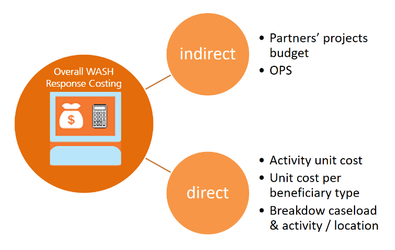...
Estimate the overall WASH response funding requirements
The HRP is also a funding appeal document, where funding requirements of each cluster are presented separately and consolidated to form the total funding requirement for the response. Each sector is responsible to estimate the budget needed to implement the sectorial strategy for the coming year/phase. This is a complicated task : as many parameters must be considered, and many variables are still unknown during planning phase, which can change the overall budget. Nevertheless, response costing must be done quickly enough for funding to be allocated without delay. Even if estimations estimates are rough, it is important to be transparent and be able to explain later how figures were calculated. Cluster response budget also represents a target, budgets also represent targets against which funding allocation will be regularly measured; funding monitoring figures are used as an advocacy tool in case of insufficient funding level. Such monitoring of the funding status is used to advocate for further efforts in resource mobilization efforts during throughout the response when necessary.
| Response costing method |
As defined in the diagram above, there are two ways for WASH Cluster coordinator coordinators to estimate WASH response budget as:
1- Indirect costing: In protracted emergencies, in September, partners are requested to summarize and upload their planned projects for the next year on the OPS website. Cluster coordinators can be asked to pre-validate their project projects making sure they meet minimum criteria. Operational Response Plan’s cost costs can be calculated by adding up requested budgets from all approved partner’s planned proposals. This method can be used in sudden onset emergencies. The positives and negatives of this include:
- Pros
...
- as quick,
...
- participatory, field oriented, partners can in theory factor in their capacity
- Cons
...
- as can be very inaccurate because:
-Partners have tendency to overestimate their funding requirements, and do not necessarily factor in access and capacity
...
-Subjective, based on partner’s estimation
2- Direct costing: The WCC use caseload figures, priority activities and unit prices to estimate total response budget him/herselfthemselves. Activities/beneficiaries unit costs can be estimated directly, or taken from partners’ former projects’ final report (reports’ budget are indeed preferred to proposal ‘s budget, as cost are usually more accurate).
- Pros: apparent accuracy. Can provide further guidance to partners’ proposal evaluation in terms of unit cost. Help to evaluate future projects cost. Based on population figures/caseload, so access and capacity already factored in.
- Cons: time consuming for HWCP, based on population figures that are sometimes inaccurate, not participativeparticipatory. Unit cost can be only approximativeapproximate, and vary from one place to another.
...
| Note | ||
|---|---|---|
| ||
|
...
